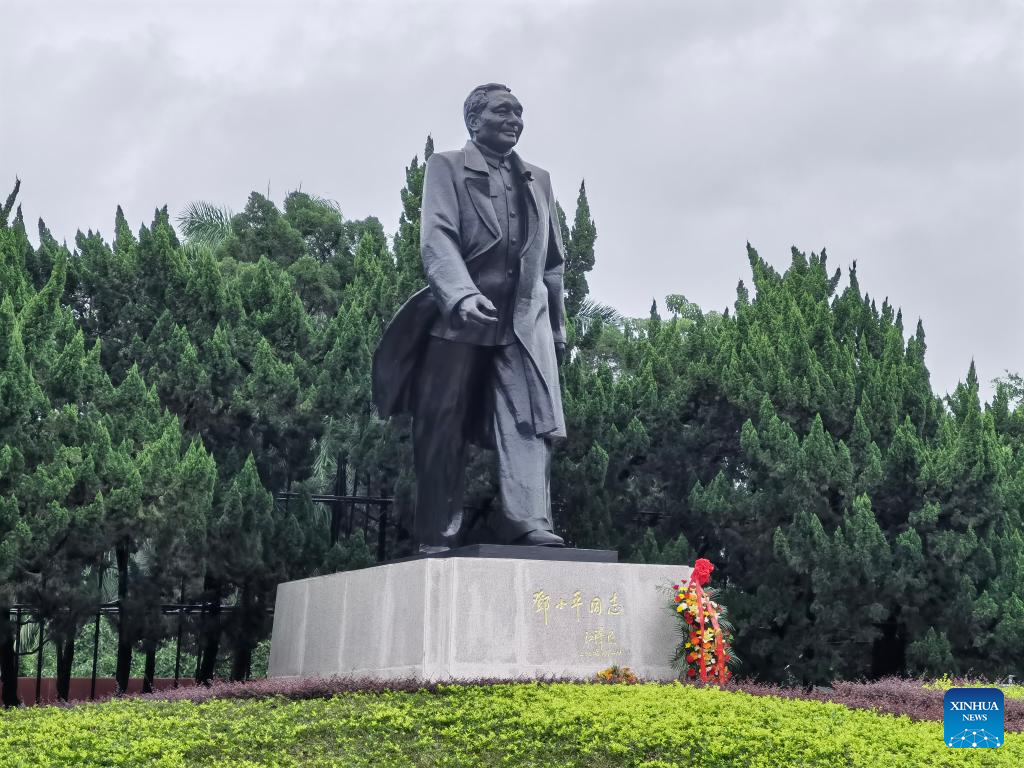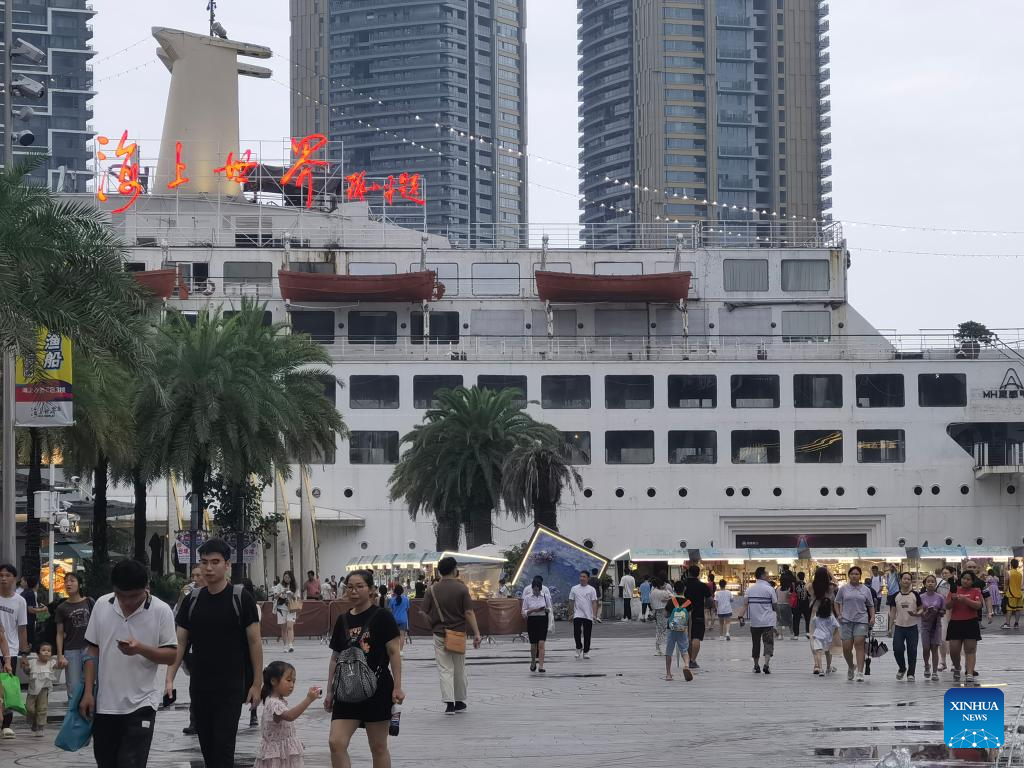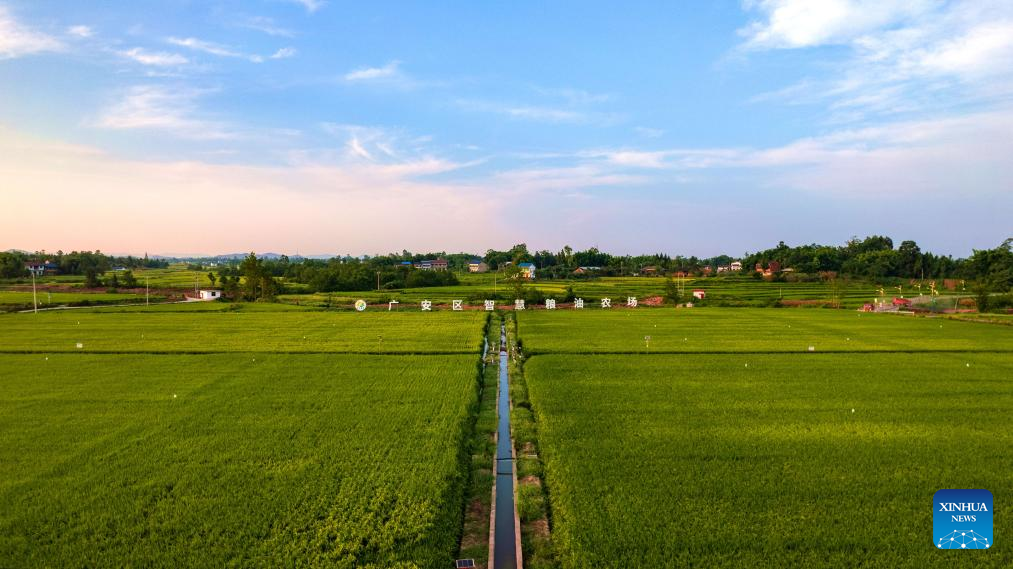
The bronze statue of Deng Xiaoping is pictured on the hilltop of the Lianhua Hill Park in Futian District of Shenzhen, south China's Guangdong Province, Aug. 20, 2024. Xinhua/Hong Zehua)
CHENGDU/SHENZHEN, Aug. 23 (Xinhua) -- Lan Zongguo remembers Deng Xiaoping for one thing: Reforms led by the late Chinese leader put bowls of rice in the hands of his four sisters. On Thursday, China marked Deng's 120th birth anniversary.
Lan, a 58-year-old peasant, is the only son in his family in Huaqiao Town of Guang'an City, Deng's hometown in southwest China's Sichuan Province. The town is famous for rice production, but in the 1970s when the countryside was still in the grip of patriarchal norms and scarcity, Lan was the only one in the family allowed to eat their modest ration of rice.
"At dinner time, I was the only kid to get a bowl of rice. My two elder sisters would silently eat their share of corn paste, while my younger sisters would surround me hoping to get a spoonful of rice," he said.
Lan's parents worked in a production team under a "people's commune." This collective system pooled manpower to improve irrigation and road facilities in rural China, but its egalitarian distribution dented farmers' enthusiasm for work and resulted in reduced output.
In the early 1980s, under Deng's leadership, China actively promoted the "household contract responsibility system," a reform that allocated collective land to individual households, allowing farmers to manage their own production and keep most of their harvest. As with many Chinese reforms, it began as a local experiment by a group of farmers in Anhui Province before being promoted nationwide by the central leadership.
Guang'an embraced the reform in 1983, and Lan's family was allocated 5 mu (about 0.3 hectares) of land. The increase in output was enormous: Their paddy yielded 1,750 kg of rice annually, of which the family kept 1,600 kg, compared with the 150-200 kg they used to receive in rations.
"Every member of my family could enjoy a bowl of rice, and there was even excess rice that we could sell in the market," Lan said, recalling the situation after the reform.

An aerial drone photo taken on Aug. 7, 2024 shows the paddy fields at Zhulin Village in Huaqiao Town of Guang'an City, southwest China's Sichuan Province. (Photo by Wang Yining/Xinhua)
With improved productivity among farmers, China's grain output jumped to over 407 million tonnes in 1984, up 33.7 percent from the 1978 figure. In 1990, the output further went up to 435 million tonnes.
The household responsibility reform is deemed a hallmark of Deng's early stage of reform. In China, Deng is venerated as the "chief architect of China's economic reform, opening up and modernization."
The reform and opening-up drive led by Deng started China's historic transformation from a planned economy with a per capita GDP of around 200 U.S. dollars into the world's second-largest economy.
In Shenzhen, the symbolic hub of China's reform and opening-up drive, Deng's bronze statue is consistently adorned with flowers from entrepreneurs and local residents.
"Shenzhen has become a paradise for innovation and entrepreneurship. Many people who have realized their dreams here believe it would not be possible without Deng and the reform and opening-up," said Zhang Xi, a director with the Lianhuashan Park, where the statue is located.
In 1980, Shenzhen established one of China's earliest special economic zones (SEZs) to allow foreign companies to set up factories. The SEZ model injected much-needed capital, technology and management expertise into China's manufacturing sector and was later introduced in many other parts of the country.
In 1992, in his famous southern China tour, Deng expressed support for Shenzhen's bold reforms and encouraged the fast-developing city to keep on its way.
China is now a hotspot for foreign investment. In 2023, the number of newly established foreign-invested enterprises in the country reached 53,766, representing a growth of 39.7 percent year on year.
Television giant Konka, established in 1980 in the Shenzhen SEZ, was an early beneficiary of Deng's reforms. The company started by producing black-and-white TVs to cater to a burgeoning domestic market for consumer electronics, unlocked by a set of market-oriented reforms.
The SEZ allowed for the import of foreign equipment and technologies, which greatly raised the company's efficiency and product quality, said Zhou Bin, president of Konka Group Co., Ltd.
"By allowing companies to access foreign resources, the reform and opening-up drive has created a better environment for innovation, which in turn accelerated China's social and economic development," he said.

This photo shows an exterior view of "Minghua" steamship, also known as "A World on the Sea" with the name written by Deng Xiaoping in Shenzhen, south China's Guangdong Province, Aug. 19, 2024. Xinhua/Hong Zehua)
REFORMS CONTINUE
Over 40 years after the SEZ took off, Shenzhen still lies at the forefront of China's reform and opening up. In 2019, the city was tasked with building a "pilot demonstration area of socialism with Chinese characteristics" and developing replicable reforms for other regions.
The metropolis is now home to over 23,000 hi-tech firms, including tech heavyweights like Huawei, Tencent and BYD.
"The reform and opening up revitalized China's then economic and social development. As the country faces a changing domestic and international environment, deepening reform is an inevitable choice," Zhou said.
Reforms have continued in the countryside as well. In 2004, China allowed farmers to transfer management rights of their allotted lands, meaning they could lease farmland to others. Ten years later, the central government issued policies to promote nationwide land transfer to encourage large-scale farming and agricultural modernization.
In Huaqiao Town, over a third of the farmland is now leased out. By consolidating fragmented fields, local farmers have created 2,600 hectares of "high-standard farmland" featuring mechanization and modern management practices.
"Unmanned machines manage the entire farming process from sowing to harvesting, which farmers can monitor and control through their smartphones," said Qin Qigui, an official of Huaqiao's Chongfeng Village.
For Lan's family, rural reforms since the 1980s have not only unshackled them from hunger but also empowered them to embrace prosperity in diverse ways.
Lan has leased out most of the contracted farmland and switched to other jobs like minibus driver and farm machinery operator. He and his wife earn about 160,000 yuan (about 22,500 U.S. dollars) per year and own a three-story house and two cars.
All his four sisters now live in Guangdong Province. After working for years as migrant workers, his two younger sisters used their savings to open a factory producing garments for export.
"Now we all live a 'Xiaokang' life," Lan said. In 1979, Deng proposed "Xiaokang," meaning moderately prosperous, as a goal of the country's modernization. In 2021, China announced the completion of building a Xiaokang society in all respects, before it embarks on the new journey of building a great modern socialist country in all respects. ■

An aerial drone photo taken on Aug. 7, 2024 shows the paddy fields at Chongfeng Village in Huaqiao Town of Guang'an City, southwest China's Sichuan Province. (Photo by Wang Yining/Xinhua)



